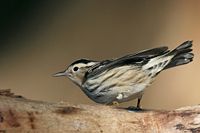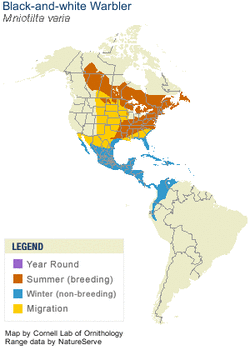Black-and-white Warbler
Facts
Conservation Status: Least Concern
Location: North, Central, and parts of north South America
Lifespan: Average 11 years
Conservation Status: Least Concern
Location: North, Central, and parts of north South America
Lifespan: Average 11 years
Scientific Classification
Kingdom: Animalia
Phylum: Chordata
Class: Aves
Order: Passeriformes
Family: Parulidae
Genus: Mniotilta
Species: M. varia
Binomial name: Mniotilta varia
Kingdom: Animalia
Phylum: Chordata
Class: Aves
Order: Passeriformes
Family: Parulidae
Genus: Mniotilta
Species: M. varia
Binomial name: Mniotilta varia
Description
Length: 11 to 13 cm (4.3 to 5.1 cm)
Wingspan: 18 to 22 cm (7.1 to 8.7 in)
Weight: 8 to 15 g (0.3 to 0.5 oz)
Other: The summer male Black-and-white Warbler is boldly streaked in black and white, and the bird has been described as a flying humbug. There are two white wing bars. Female and juvenile plumages are similar, but duller and less streaked.
Length: 11 to 13 cm (4.3 to 5.1 cm)
Wingspan: 18 to 22 cm (7.1 to 8.7 in)
Weight: 8 to 15 g (0.3 to 0.5 oz)
Other: The summer male Black-and-white Warbler is boldly streaked in black and white, and the bird has been described as a flying humbug. There are two white wing bars. Female and juvenile plumages are similar, but duller and less streaked.
Behaviour
The Black-and-white Warbler is diurnal and migratory. It is generally solitary, but it joins mixed-species flocks in winter and during migrations.
It is territorial and defends its space. The males sing while driving other birds from their territory. The females flush and perform a distraction display if disturbed on the nest. The Black-and-white Warbler creeps along branches and trunks from the canopy to the ground, picking and probing with its thin bill. It can forage upside-down along the branches, and may creep downward head first. It forages from bark, and can glean dormant insect’s forms. It also uses other foraging behaviours, including flycatching and foliage gleaning. The song is a highsee wee-see wee-see wee-see wee-see wee-see, and the call is a hard tick.
The Black-and-white Warbler is diurnal and migratory. It is generally solitary, but it joins mixed-species flocks in winter and during migrations.
It is territorial and defends its space. The males sing while driving other birds from their territory. The females flush and perform a distraction display if disturbed on the nest. The Black-and-white Warbler creeps along branches and trunks from the canopy to the ground, picking and probing with its thin bill. It can forage upside-down along the branches, and may creep downward head first. It forages from bark, and can glean dormant insect’s forms. It also uses other foraging behaviours, including flycatching and foliage gleaning. The song is a highsee wee-see wee-see wee-see wee-see wee-see, and the call is a hard tick.
Predators or Prey?
The Black-and-white Warbler is probably vulnerable to predation as a ground nesting species. Probable nest predators include common forest bird and mammal species such as blue jays, deer mice, chipmunks, northern flying squirrels, red squirrels, raccoons and black bears. This species has many prey such as caterpillars, flies, bugs, beetles, spiders, and larvae.
The Black-and-white Warbler is probably vulnerable to predation as a ground nesting species. Probable nest predators include common forest bird and mammal species such as blue jays, deer mice, chipmunks, northern flying squirrels, red squirrels, raccoons and black bears. This species has many prey such as caterpillars, flies, bugs, beetles, spiders, and larvae.
Diet
These birds feed on insects and spiders, and unlike other warblers, Black-and-white Warblers forage like a nuthatch, moving up and down tree trunks and along branches.
These birds feed on insects and spiders, and unlike other warblers, Black-and-white Warblers forage like a nuthatch, moving up and down tree trunks and along branches.
Habitat
The breeding habitat is broadleaved or mixed woodland, preferably in wetter areas.
The breeding habitat is broadleaved or mixed woodland, preferably in wetter areas.
Conservation
Breeding Bird Survey data indicate a steady decline in Blackand-White Warbler populations in New York since 1966. NYS Breeding Bird Atlas data reflect a decline in distribution, particularly in the southern part of the Hudson River Valley. Partners in Flight lists it as a Species of Regional Concern in Bird Conservation Regions 13 and 30, and as a Species of Regional Stewardship for BCR 14.
Breeding Bird Survey data indicate a steady decline in Blackand-White Warbler populations in New York since 1966. NYS Breeding Bird Atlas data reflect a decline in distribution, particularly in the southern part of the Hudson River Valley. Partners in Flight lists it as a Species of Regional Concern in Bird Conservation Regions 13 and 30, and as a Species of Regional Stewardship for BCR 14.
Reproduction
The female builds the nest almost alone. It is a cup, often on the ground at the base of a tree or fallen log, and hidden under dead leaves or branches. The nest is made on leaves, coarse grass, with other fine materials used for lining. The female lays 4 to 6 white eggs flecked with brown. Incubation lasts about 10 to 12 days, by female. Male sometimes feeds her at nest. Both parents feed the young and defend the nest. Chicks leave the nest 8 to 12 days after hatching. They remain 2 to 3 weeks in the territory after fledging. Generally, there is only one brood per year, sometimes two.
The female builds the nest almost alone. It is a cup, often on the ground at the base of a tree or fallen log, and hidden under dead leaves or branches. The nest is made on leaves, coarse grass, with other fine materials used for lining. The female lays 4 to 6 white eggs flecked with brown. Incubation lasts about 10 to 12 days, by female. Male sometimes feeds her at nest. Both parents feed the young and defend the nest. Chicks leave the nest 8 to 12 days after hatching. They remain 2 to 3 weeks in the territory after fledging. Generally, there is only one brood per year, sometimes two.



